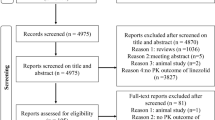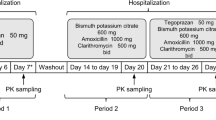Summary
Terfenadine is a nonsedating histamine H1-antagonist that, when given with ketoconazole, results in accumulation of parent terfenadine and altered cardiac repolarisation in susceptible individuals. This prospective cohort study, designed to assess macrolide effects on terfenadine pharmacokinetics and electrocardiogram (ECG) parameters, evaluated 18 healthy male and female volunteers who received terfenadine to steady-state. Equal numbers (6) were randomised to receive either erythromycin, clarithromycin or azithromycin at recommended doses while continuing terfenadine. Macrolide monotherapy effects on the ECG were also investigated. Pharmacokinetic profiles for terfenadine were performed before and after the addition of macrolide therapy, and ECGs were obtained at baseline and predose on days of blood sampling.
Erythromycin and clarithromycin significantly affected the pharmacokinetics of terfenadine. Three of 6 volunteers receiving erythromycin and 4 of 6 receiving clarithromycin demonstrated accumulation of quantifiable unmetabolised terfenadine that was associated with altered cardiac repolarisation. Azithromycin had no effect on terfenadine pharmacokinetics or cardiac pharmacodynamics.
Similar content being viewed by others
References
Amacher DE, Schomaker SJ, Retsema JA. Comparison of the effects of the new azelide antibiotic, azithromycin, and erythromycin on rat liver cytochrome P-450. Antimicrobial Agents and Chemotherapy 35: 1186–1190, 1991
Bazett HC. An analysis of the times relations of electrocardiograms. Heart 7: 353–370, 1920
Bethea RM, Duran BS, Bouillon TL. Statistical methods for engineers and scientists, 2nd ed., Marcel Dekker, New York, 1985
Breimer DD, Schellens JHM, Soons PA. Nifedipine: variability in its kinetics and metabolism in man. Pharmacology and Therapeutics 44: 445–454, 1989
Caron J, Lacroix D, Libersa C. Long QT and astemizole: a risky combination. Abstract. First European Symposium of Pharmacovigilance, Strasbourg, France, October, 1990
Crane JK, Shih Hue-Teh. Syncope and cardiac arrhythmia due to an interaction between itraconzole and terfenadine. American Journal of Medicine 95: 445–446, 1993
Cortese LM, Bjomson DC. Comment: the new macrolides and terfenadine. Letter. Annals of Pharmacotherapy 26: 1019, 1992
Coutant JE, Westmark PA, Nardella PA, Walter SM, Okerholm RA. Determination of terfenadine and terfenadine acid metabolite in plasma using solid-phase extraction and high-performance liquid chromatography with fluorescence detection. Journal of Chromatography 570: 139–148, 1991
FDA Medical Bulletin. September 22: 2, 1992
Garteiz DA, Hook RH, Walker BJ, Okerholm RA. Pharmacokinetics and biotransformation studies of terfenadine in man. Arzneimittel-Forschung 32: 1185–1190, 1982
Gascon MP, Dayer P. Comparative effects of macrolide antibiotics on liver monoxygenases. Abstract. Clinical Pharmacology and Therapeutics 49: 158, 1991
Gibaldi M. Biopharmaceutics and clinical pharmacokinetics. Lea and Febiger, Philadelphia, 1984
Honig PK, Woosley RL, Zamani K, Conner DP, Cantilena LR. Changes in the pharmacokinetics and electrocardiographic pharmacodynamics of terfenadine with concomitant administration of erythromycin. Clinical Pharmacology and Therapeutics 52: 231–238, 1992
Honig PK, Wortham DC, Zamani K, Conner DP, Mullin JC, et al. The terfenadine-ketoconazole interaction: pharmacokinetic and electrocardiographic consequences. Journal of the American Medical Association 269: 1513–1518, 1993
Matthews DR, McNutt B, Okerholm R, Flicker M, McBride G. Torsades de pointes occurring in association with terfenadine use. Letter. Journal of the American Medical Association 266: 2375–2376, 1991
Monahan BP, Ferguson CL, Killeavy ES, Lloyd BK, Troy J, et al. Torsades de pointes occurring in association with terfenadine use. Journal of the American Medical Association 264: 2788–2790, 1990
Nattel S, Ranger S, Talajic M, Lemery R, Roy D. Erythromycin induced long QT syndrome: concordance with quinidine and underlying cellular electrophysiological mechanisms. American Journal of Medicine 89: 235–238, 1990
Periti P, Mazzei T, Mini E, Novelli A. Pharmacokinetic drug interactions of macrolides. Clinical Pharmacokinetics 23: 106–131, 1992
Peters DH, Clissold SP. Clarithromycin: a review of its antimicrobial activity, pharmacokinetic properties, and therapeutic potential. Drugs 44: 117–164, 1992
Peters DH, Friedel HA, McTavish D. Azithromycin: a review of its antimicrobial activity, pharmacokinetic properties, and clinical efficacy. Drugs 44: 750–799, 1992
Roden DM, Woosley RL, Primm RK. Incidence and clinical features of the quinidine associated long QT syndrome: implications for patient care. American Heart Journal 111: 1088–1093, 1986
Schwartz PJ, Locati E, Priori SG, Zaza A. The long Q-T syndrome. In Zipes et al. (Eds) Cardiac electrophysiology: from cell to bedside, Saunders, Philadelphia, 1990
Sorkin EM, Heel RC. Terfenadine: a review of its pharmacodynamic properties and therapeutic efficacy. Drugs 29: 34–56, 1985
Tinel M, Descatoire V, Larrey D, Loeper J, Labbe G, et al. Effects of clarithromycin on cytochrome P-450: comparison with other macrolides. Journal of Pharmacology and Experimental Therapeutics 250: 746–751, 1989
Transcript of FDA Proceedings. Pulmonary-Allergy Drugs Advisory Committee, June 11, 1990. Department of Health and Human Services. Public Health Service. Food and Drug Administration, Rockville, Maryland, 1990
Woosley RL, Chen Y, Freiman JP, Gillis RA. Mechanism of the cardiotoxic actions of terfenadine. Journal of the American Medical Association 269: 1532–1536, 1993
Yun CH, Okerholm RA, Guengerich FP. Oxidation of the antihistaminic drug terfenadine in human liver microsomes. Drug Metabolism and Disposition 21: 403–409, 1993
Author information
Authors and Affiliations
Rights and permissions
About this article
Cite this article
Honig, P.K., Wortham, D.C., Zamani, K. et al. Comparison of the Effect of the Macrolide Antibiotics Erythromycin, Clarithromycin and Azithromycin on Terfenadine Steady-State Pharmacokinetics and Electrocardiographic Parameters. Drug Invest 7, 148–156 (1994). https://doi.org/10.1007/BF03258467
Published:
Issue Date:
DOI: https://doi.org/10.1007/BF03258467




